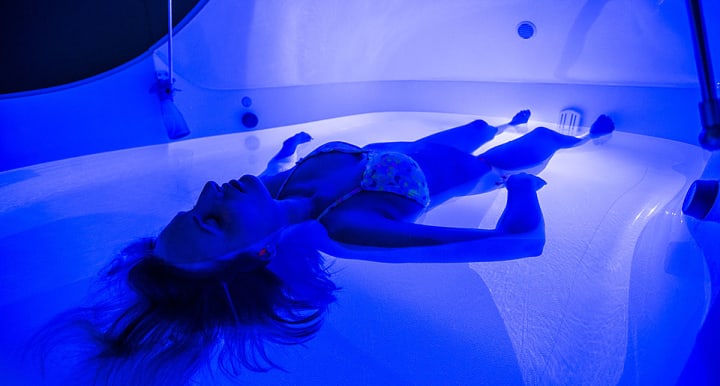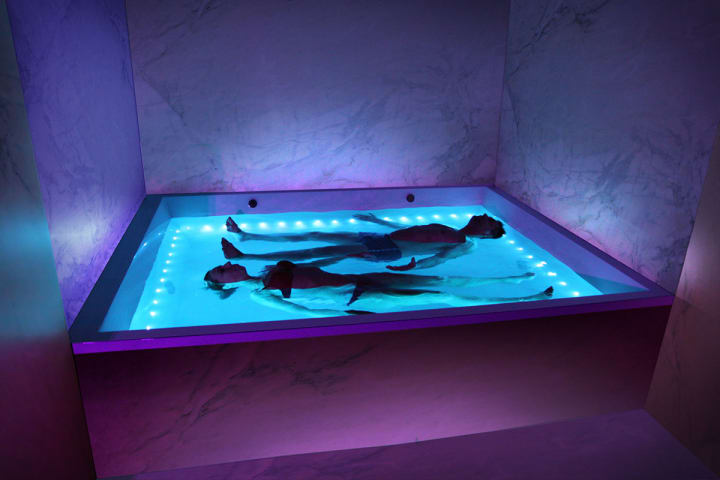What Is Floating Therapy?
Saltwater and floating therapy might be the answer to those chronic aches and pains.

Floating therapy, sometimes referred to as sensory deprivation, is a developing method of stress relief and relaxation used by thousands that is rapidly gaining popularity. It occurs in a floatation tank, which typically are about 5' wide and 8' and tall. The tank serves to block out all external light and noise stimuli, which is where the name "sensory deprivation tank" stems from. Today, professional athletes are increasingly using floating therapy to help the process of muscle recovery, adding to its growing popularity.
Inside the tank is a pool of water that is kept exactly at 93.5 degrees Fahrenheit in order to mimic the natural human skin temperature. The water is generally 1-2' deep, which doesn’t appear to be enough to float in. However, the water has massive amounts of Epsom salts dissolved in it. Like is seen in naturally occurring high salinity water, such as the Dead Sea, the dense water makes humans more buoyant.
Floatation centers and spas generally sell floating therapy in one-hour sessions, although shorter and longer time sessions also exist. In a standard visit, guests just simply float for the duration of their session in darkness and meditate silently. However, there are also options to leave lights on, or to perform active meditation while floating.
History of Floating Therapy

John C. Lilly invented the prototype sensory deprivation chamber in 1954, but not for the purpose of floating therapy. Lilly had graduated from the University of Pennsylvania with a medical degree in 1942. He created the original floatation chamber in order to block out external stimuli and study human consciousness in its most basic state. The original floatation chamber Lilly designed required participants to be submerged completely in cylindrical tanks and to wear helmets that drew oxygen from the surface
Glenn Perry attended a workshop that Lilly was hosting in 1972, and was so impressed by the results of using the sensory deprivation chamber that he aimed to develop a commercialized version that would be accessible to the general public. Under Lilly’s mentorship and guidance, Perry invented the modern floatation chamber that is still being used today.
In the 1970s the term R.E.S.T. (Restricted Environmental Stimulation Therapy) was created, which marked the beginning of the floating therapy movement. The research into floating chambers and their possible impact on human health was pioneered by Rod Borrie. Borrie carried out REST research through the 1970s, and by the 80s and 90s established a unique therapy center in New York that utilized floatation tanks. Rod Borrie’s research and innovations have paved the way for where floating therapy is today.
Benefits of Floating Therapy

One of the primary benefits of floating therapy is an improved cognitive function. In an era where we are constantly surrounded by electronic devices and screens, the pure darkness and silence inside a floatation chamber harbors an environment that makes relaxation easily attainable. One way this improves mental well-being is through stress reduction. Without worrying about checking emails from work or text messages from family, the human mind is able to self-reflect rather than concentrating on other issues that weigh us down. This sort of distraction from life’s stresses leads to a huge mental relaxation.
Another way floating therapy improves mental health is that it allows for better sleep. It has been proven that the prolonged staring at the blue light that is emitted from electronic screens decreases the formation of melatonin, a hormone that is responsible for regulating mammalian sleep-wake cycles. The sensory deprivation tank counters those effects and allows for efficient sleep cycles. Next, floating helps those that suffer from anxiety disorders. People that suffer from PTSD, public speaking anxiety, and many other anxiety disorders have found that upon leaving the chamber, their anxiety symptoms are massively reduced. Finally, floating allows people with writer’s block a rejuvenated creativity. Artists and authors are among one of the groups who frequent floating therapy the most because it has been reported on numerous occasions that floating helps restore creativity. It is believed that with no distractions and nothing but self-reflection in the chamber, people are given the most productive environment possible to focus on their thoughts.
The other major benefit that floating therapy offers is an improved muscular relaxation. Floating on a surface that has twice the salinity of the Dead Sea allows people to experience the closest thing to zero gravity that the average person will ever try. Because of this, floating therapy counters the pressures that gravity places on the human body every day. People suffering from arthritis often visit float therapy centers in order to relieve joint pain. In addition, professional athletes have begun using floating to relieve muscle pain and to help the muscle rebuilding process. When a person is exercising, the muscle fibers are ripped apart and reformed. The soreness that a person feels after a good workout is the muscle rebuilding process. It is proposed that the floating process assists in the muscle rebuilding process while alleviating the pain that comes with muscle building.
Advocates of Floating Therapy

Stand-up comedian and UFC commentator Joe Rogan is a major advocate of floating therapy. Rogan has spoken out on how it took him multiple attempts to be vulnerable enough to enjoy the maximum benefits that floating has to offer, saying that he didn’t completely let go the first few times. At one point, Rogan stated, “The sensory deprivation chamber has been the most important tool that I’ve ever used for developing my mind, for thinking, for evolving.”
NBA stars Harrison Barnes and Steph Curry are also major advocates of floating therapy. In an interview with ESPN, they stated that they enjoy both the mental and physical benefits that come with floating. They said that on top of relieving the stresses that come with the pressures of being NBA stars, and the mental stresses of everyday life, that their trainer suggested it to them because the high salt and magnesium content helps restore electrolytes that are lost in sweat, and rejuvenate muscle.
In addition, the scientific community has also endorsed floating therapy. In 1990, the International Journal of Mental Health and Addiction concluded that floating was a successful way at moderating any type of behavioral or attitudinal changes. BMC Complementary and Alternative medicine published that in 2014 that the research subjects who utilized floating scored better in optimism and sleep quality, and lower in stress, pain and depression. In 2016, BMC Complementary and Alternative Medicine conducted a randomized trial with people suffering from General Anxiety Disorders in which the floating group showed improved sleep, less depression, and less impactful anxiety effects when compared to the group that didn’t undergo floating therapy.
About the Creator
Mackenzie Lu
Namaste. Active yogi and life enthusiast. It has become her mission to spread the benefits of having the mind, body, and soul in tune with one another.






Comments
There are no comments for this story
Be the first to respond and start the conversation.